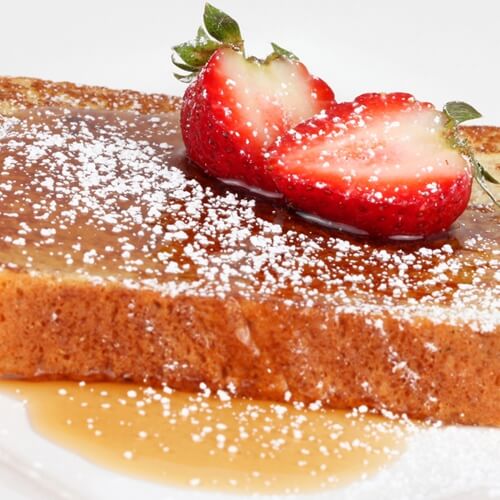3 Tips For Making Perfect French Toast
While its most popular moniker is French toast, this breakfast delight has several other names it also goes by. That list includes Spanish toast, German toast and the ever so quaint eggy bread. More than just differentiating between regions, each of the names indicates how a culture put their unique spin on this breakfast staple. For example, Hong Kong–style French toast is dipped in egg and soy and then deep fried. You too can put your spin on this globally beloved dish by learning how to cook french toast yourself. All you need is a few ingredients, the right tips and a healthy appetite.
The bread matters
As a rule, bread is sort of the centerpiece of French toast, and as such, you want to make sure you pick the right kind. Standard white bread is often the most popular choice, but why not experiment with other varieties? Though less inherently creamy, country style breads make for a much sturdier French toast. Meanwhile, French baguettes often result in far more chewy slices overall. For extra smooth French toast, opt for either Challah or egg bread. No matter what you choose, always go for unsliced loaves so you dictate the thickness of your own slices. The best slices are usually between three-quarters to an inch in thickness. Also be aware that during the cooking process, French toast can expand, so keep that in mind as you slice and prepare.
Watch your custard
Once you’ve got your bread chosen, it’s important to think about the custard you’ll be whipping up. This is what you’ll be dipping the slices into, and you want to ensure it has the right consistency. The first part of creating that perfect custard is how much milk and sugar you use. Too much of the former can ruin the toast, leaving it soggy and undercooked. Meanwhile, you want to avoid adding in too much sugar as well. Because you’ll eventual cover your completed French toast in honey or maple syrup, excess sugar can result in overly saccharine slices. It’s also important to consider how you’ll mix the custard. The perfect custard should have few lumps – meaning no bits of egg or any spices – and should be a nice golden yellow in color.
Not all syrup is the same
In recent years, the USDA has taken measures to clarify the various kinds of syrup being sold. Generally speaking, most maple syrups fall under four distinct types, all referred to as Grade A. The most widely available are the amber-colored syrups that have a rich taste. There are also syrups described as having a golden color and delicate taste. Meanwhile there are two syrups that have very dark colors, and both have tastes described as strong and robust. Knowing which to use is a personal preference, and it’s important to be aware of what you’re buying beforehand. Another consideration is when you actually buy the syrup. As the harvest season comes to a close, sugar in the sap tends to drop. This results in syrups that are darker in color and have a stronger taste.


